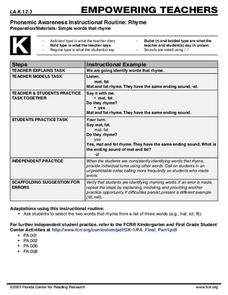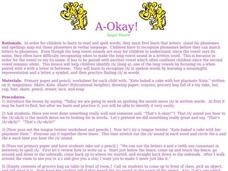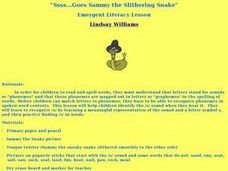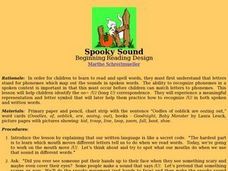Florida Center for Reading Research
Phonemic Awareness Instructional Routine: Rhyme
As a class, kindergarteners identify rhyming words. The teacher provides an example of a rhyming pair and explains why they rhyme. Individual learners then respond by saying a word that rhymes with a given word.
Curated OER
Mouse Mess
Scholars practice rhyming and phonemic awareness using trade books and poetry. They will listen to the book Mouse Mess several times throughout the week, identifying rhyming words, and matching words that begin with the same sound. Then...
Achieve3000
Discriminating Phonemes
Develop the fluency of beginning readers one sound at a time with this phonemic awareness lesson. Through a series of whole-class instruction, independent practice, and collaborative learning activities, children practice identifying the...
Florida Center for Reading Research
Phonological Awareness: Rhyme, Rhyme or No Rhyme
Rhyming is fun, builds phonemic awareness, and is a tried and true pre-reading skill. This activity helps learners identify words that rhyme. Young scholars listen to a song, locate a rhyming word they hear by clapping then draw a...
Curated OER
Phonemic Awareness, Say It and Move It
Students clap and count sounds when saying different words. In this phonemic awareness lesson plan, students move bingo chips around when hearing a certain number of sounds in words.
Florida Center for Reading Research
Phonics: Letter-Sound Correspondence, Medial Phoneme Spin
A collaborative activity challenges young scholars to match medial graphemes and phonemes. Pairs take turns spinning the spinner, naming the letter, and saying its name. They choose from a stack of cards with the same medial sound.
Curated OER
Finding Rhyming Words in a French Poem
Explore rhyming in this phonemic awareness and French lesson plan. Listen to the poem "J'Adore la Pizza" by Karen Kransky and identify rhyming words. Compare grapheme spelling patterns with like phonemes, and sort word cards according to...
Curated OER
We Flew With a Baboon
More vowels? Elementary schoolers recognize how vowel patterns change a short vowel sound into a long vowel sound. With an emphasis on the /oo/ that makes the long U sound, kids identify the phoneme and letter combination through...
Curated OER
Amazing As
Help young readers recognize the short vowel /a/ in written and spoken language. Through matching and listening activities, they discriminate the vowel sound /a/ from other phonemes. Learners associate the phoneme with its letter...
Curated OER
Rainbow Spelling: A Kinesthetic Approach to Encoding
Have your young learners interact with phonemes through this tactile plan! Each learner will have a colored mat where they connect different phonemes to create words. The best part is that they can self-correct easily as they spell!
Curated OER
Ehhh...What'd you say?
Practice pronouncing and spelling words with the /e/ sound with spellers. They blend phonemes with spelling maps to master important representation and letter symbol of the short vowel /e/. They also make sock puppets and study the...
Curated OER
It's Time to Open Wide for O
Students recognize the short vowel o in written and spoken language. Through listening and decoding activities, they discriminate the vowel sound /o/ from other phonemes. Students match the phoneme and letter in words they read on index...
Curated OER
Beginning Consonants
First graders practice with beginning consonant sounds, including identifying initial consonants and matching letter sounds to their corresponding letters. They recognize beginning consonant sounds by reading and listening to a story...
Curated OER
A-Okay
Learners distinguish between short and long vowel /a/ sounds. They are introduced to the vowel-consonant-e pattern that changes short vowel sounds into long vowel sounds. Then they practice identifying words with the vowel-consonant-e...
Curated OER
Language Arts: Phonemes and Short Vowels
Students identify the short u vowel sound and recognize phonemes in spoken words. By orally practicing tongue twisters, they recognize how to pronounce the sounds. In a written assessment, students examine pictures, name the objects,...
Curated OER
Here Kitty, Kitty
Young scholars recognize the short vowel i in written and spoken language. Through matching activities, they discriminate the short vowel /i/ from other vowel sounds. Students associate the phoneme with its letter representation and...
Curated OER
N is for Nest
Learners identify the letter and phoneme /n/ in written and spoken language. Students practice the production of the /n/ sound through listening and matching activities. They identify the initial placement of the letter and sound using a...
Curated OER
A? Speak up, I can't hear you!
Young scholars become phonemically aware of various sounds that make up written words. This activity focuses on the vowel correspondence a_e=/A/. They decode the long a mouth moves in words as well as practice spelling the words themselves.
Curated OER
"Ssss...Goes Sammy the Slithering Snake"
Students practice recognizing the phonemes/grapheme's in /s/ sounds in words. They also practice viewing the representation of the letter symbol s and the picture of Sammy the Snake. The tongue twister "Sammy the sneaky snake slithered...
Curated OER
The Loud Trout Shouts!
Students practice the strategies of phonemes and digraphs dealing with the correspondence "ou"=/ow/ in both spoken and written words. They listen as the book The Napping House by Audrey Wood is read to them and then they interact with...
Curated OER
Short 'e'
First graders recognize the short vowel e in written and spoken language. Through matching activities, they discriminate the short vowel /e/ from other phonemes. Students associate the phoneme with its letter representation and identify...
Curated OER
The Scary, Creaky Door
Students recognize the short vowel e in written and spoken language. Through listening and matching activities, they discriminate the vowel sound /e/ from other phonemes. Students identify the phoneme and letter in pictures using a...
Curated OER
Spooky Sound
First graders explore the concept of vowel digraphs. They distinguish between the sound made by one vowel and two vowels. Through listening, matching, and writing activities, 1st graders identify the sound in words and sentences they...
Curated OER
Egg-stra!! Egg-stra!!
Students recognize the short vowel e in written and spoken language. Through matching activities, they discriminate the short vowel /e/ from other phonemes. Students associate the phoneme with its letter representation and identify the...

























